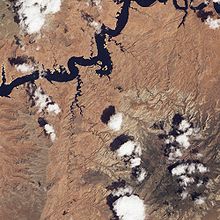Rainbow Bridge National Monument
| Rainbow Bridge National Monument | |
|---|---|
 | |
 | |
| Location | San Juan County, Utah, United States |
| Nearest city | Page, Arizona |
| Coordinates | 37°04′38″N 110°57′51″W / 37.07722°N 110.96417°W |
| Area | 160 acres (65 ha)[1] |
| Created | May 30, 1910 |
| Visitors | 86,369 (in 2016)[2] |
| Governing body | National Park Service |
| Website | Rainbow Bridge National Monument |
Rainbow Bridge is a
History


Located in the rugged, isolated canyons at the feet of
By the 1800s, Rainbow Bridge was probably seen by wandering trappers, prospectors, and cowboys. Not until 1909, though, was its existence publicized to the outside world. Two separate exploration parties—one headed by University of Utah Dean Byron Cummings, and another by government surveyor, W.B. Douglass—began searching for the legendary span. Eventually, they combined efforts. Paiute guides Nasja Begay and Jim Mike led the way, along with trader and explorer John Wetherill. Late in the afternoon of August 15, coming down what is now Bridge Canyon, the party saw Rainbow Bridge for the first time.[4]
The next year, on May 30, 1910, U.S. President
Rainbow Bridge became more accessible with the popularity of
In 1974, Navajo tribal members who lived in the history of Rainbow Bridge filed suit in U.S. District Court against the Secretary of the Interior, the Commissioner of the
By 1993, a National Park Service General Management Plan, involving much public input, was adopted. As part of the planning process, the National Park Service consulted with the five Native American nations affiliated with Rainbow Bridge: the Navajo,
Geology

Rainbow Bridge is made up of sandstone originally deposited by wind as sand dunes during the end of the Triassic and the Jurassic periods. The bridge lintel consists of Navajo Sandstone while Bridge Creek incises the Kayenta Formation below. Extreme fluctuations in climate during the Triassic and Jurassic periods—the region was alternately a sea and desert on par with the Sahara—produced layers of sandstone with different levels of hardness.[7] By the end of the Jurassic, the sea returned to cover these layers of sandstone and compressed them so tightly that they would persist until the present day.
As Bridge Creek flowed toward the growing Colorado River during the last ice age, it carved first through softer rocks and veered away from the harder Triassic and Jurassic sandstones, eventually creating a wide hairpin bend that flowed around a solid "fin" of sandstone that would become Rainbow Bridge. The previous course of the creek is still visible above the bridge. Water flows back on itself at bends and wide spots, creating swirling eddies along the banks. As the creek flowed around Rainbow Bridge fin, these abrasive eddies formed on both the upstream and downstream sides and cut circular alcoves in the rock wall. The sediment in the creek eventually scoured the softer layers of sandstone away, leaving the harder layers behind.
Access
Rainbow Bridge is one of the most accessible of the large arches of the world. It can be reached by a two-hour boat ride on Lake Powell from either of two marinas near Page, Arizona, followed by a mile-long walk (variable depending on Lake Powell water level) from the National Park wharf in Bridge Canyon. It is also possible to hike one or more days[8] overland from a trailhead on the southwest side of Navajo Mountain (former site of Rainbow Lodge), which requires both hiking experience and a permit obtained from the Navajo Nation in Window Rock, Arizona.[9]
Size comparison
Two other natural arches,
See also
References
- ^ "Listing of acreage – December 31, 2011" (XLSX). Land Resource Division, National Park Service. Retrieved May 14, 2012. (National Park Service Acreage Reports)
- ^ "NPS Annual Recreation Visits Report". National Park Service. Retrieved April 26, 2017.
- ^ "NABS - The Dimensions of Raiinbow Bridge". www.naturalarches.org. Retrieved December 3, 2018.
- ^ a b c d e f "History & Culture - Rainbow Bridge National Monument". National Park Service. Retrieved September 28, 2023.
- ISBN 9780966021035.
- ^ Sproul, David Kent (2001). "A Bridge Between Cultures: An Administrative History of Rainbow Bridge National Monument" (PDF). Rainbow Bridge National Monument. National Park Service. Retrieved May 3, 2018.
- ISBN 0-89577-087-3.
- ^ Gershfeld, Vitaliy (May 6, 2021). "How to Get to Rainbow Bridge National Monument (Guide)". The Nature Seeker. Retrieved June 20, 2023.
- ^ Gay, Robert. "Rainbow Bridge via South Trail, AZ". HikeArizona.com. Retrieved May 3, 2018.
- "Rainbow Bridge". NASA Earth Observatory. Archived from the original on October 1, 2006. Retrieved May 24, 2006.
